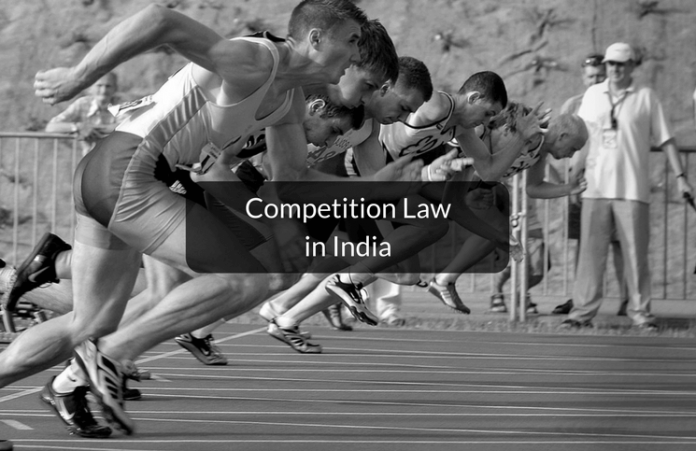In this blog post, Parthapratim Das, pursuing M.A. in business law from NUJS, Kolkata, talks about the development of competition law in India.
The History of Competition Law & International Enforcement
Emperors, rulers and governments in different countries tried for years to regulate competitive markets by stabilizing prices and supporting local productions using tariffs which gradually leads to the modern competition or antitrust laws around the world. Laws related to competitive markets are found in over two millennia of history.
The earliest efforts to control price fluctuations and unfair trade practices can be traced back to the Indian and Roman civilizations. Competition is “a situation in a market in which firms or sellers independently strive for the buyers’ patronage in order to achieve a particular business objective for example, profits, sales or market share” (World Bank, 1999). Competition Law is structured to promote and provide a fair chance for healthy competition between contending competitors in the market and to protect the consumer’s interests.
The earliest ancient example of modern competition law’s ancestors is Lex Julia de Annona, during the Roman Republic around 50 BC. To protect the corn trade, heavy fines were imposed on direct, deliberate and insidious attempt to stop supply ships.The study of competition began formally in the 18th century by using different terms to describe this area like restrictive practices, the law of monopolies, combination acts and the restraint of trade in works like Adam Smith’s The Wealth of Nations.
European rulers and legislators repeatedly cracked down on monopolies in the middle ages. The end of the 19th Century saw a number of laws being enacted in the United States of America to restrict monopoly in business practices, popularly known as anti-trust laws. The doctrine of restraint of trade in English common law leads to modern competition law and the United States antitrust statutes, which in turn had great influence on the development of European community competition laws after the World War II.
Increasingly the focus has moved to international competition enforcement in a globalized economy.The Treaty of the European Community (EC Treaty of Rome) was signed by six Western European countries in 1957. Modern competition law begins with the Sherman Act of 1890 and the Clayton Act of 1914 in the United States.
Competition law has been substantially internationalized and the US model is followed globally. Presently recommendations about the competition law for the neo-liberal business economy are being made by two internationally famous organization for the world economy – (i) The United Nations Conference on Trade and Development [UNCTAD] (ii) The Organisation for Economic Co-operation and Development [OECD]
At present more than 90 countries have Competition Laws.
Provision of Constitution Leading to the Enactment of MRTP Act 1969
India has had a history of competitive markets. Kautilya‟s Arthashastra, deals with statecraft and economic policy. Articles 38 and 39 of the Constitution of India mandate that the government shall secure and protect the society where people will get social, economic and political justice and it shall address all the organizations of the nation, and the State shall direct its policy as-
- The ownership and control of material resources are so distributed as best to assist the common good.
- The economic system does not operate as it creates a concentration of wealth and means of common detriment.
The MRTP Act was in consequence of the above mentioned prevention of concentration of economic power which is the mandate in the Directive Principles of the Constitution of India. India adopted a planned economic development strategy since independence.
India chose a centrally planned economic structure also referred to as the Nehruvian socialism model. The Nehruvian model was a mixed economy model – a model that was neither a market economy like the United States of America nor a socialist economy like it was then in the USSR.
Under the mixed model, both the private and public sector co-existed. Since independence of the country in 1947, India adopted and followed policies comprising ‘command and control‘ laws, rules, regulations and executive orders.The Industrial Policy Resolution of 1948 and 1956 emphasized the state role in the industrial development, growth, social justice as a regulator by defining the parameters of regulatory mechanism.
Industrial (Department and Regulation) Act (IDRA), 1951 empowered the government to regulate almost every aspect of the functioning of the private sector. The private sector was allowed limited licensed capacity in the core sector and public sector were patronized to achieve growth and development of core industries like coal, oil & natural gas , iron & steel, power & energy etc.
It evolved a market where there was no such contestable competitor as the state controlled almost all areas of economic activities and intervened every step of the business process and financial actions of the private sector which restricted its growth and favoured public sector companies.
The public sector companies were made responsible for the economic growth of the country. Entry or exit was not easy for business. Interventions and restrictions were everywhere for private companies– from plant size to site location, from financial allocations to foreign investments.
Free competition in the market suffered a lot mainly because of Govt. policies– it only favoured public sector and big business houses as they were in a position to raise huge fund and avail technical and managerial supports to achieve the skill to grow. High tariff and no proper licence allocating system established an environment where big businesspersons succeeded in getting entry into the industry and survive with no competition. This led to the concentration of economic power in only a few individuals or business groups which created monopolistic trade practices and License-Raj.
This compelled the Government to reform the Indian economy. The license raj regime continued until the early 1990’s.The economic crisis faced by the country led to economic reforms and initiation of the New Economic Policy (NEP) 1991 and the New Industrial Policy (NIP) 1991. Competition law became very important than before in this new Liberalisation-Privatisation-Globalisation (LPG) era.
Competition has been helping the Indian consumer and industry to provide better public services since then. Greater competition boosted the Indian economy to become one of the best performers in the recent years. Competition has become a driving force in the Indian economy as an environment is essential that facilitates fair competition, restrain anti-competitive behavior and unfair trade practices.
Evolution of MRTP as a Competition Law
Even before the Glasnost and globalization which took place in the early 1990s, India took regulatory measures by means of an antitrust act named Monopolies and Restrictive Trade Practices (MRTP) Act in1969.
From 1969 to 2003 Govt. provided the regulation to the monopolistic trade for the first time by virtue of the enactment of this Monopolies and Restrictive Trade Practices Act (MPTP Act) which inspired by the mandate of the Directive Principles of State Policy in the Constitution of India. The Preamble of the MRTP Act preached a socialistic philosophy intended to ensure that the operation of the economic system did not led to the concentration of economic power to the common detriment.
The Act advocated for the prohibition of Monopolistic and Restrictive Trade Practices. However, it was not meant for all sectors of the economic system and did not apply to the public sector, government undertakings and undertakings by state & central Govt. corporation, banks , the State Bank of India and insurance companies of India which restricted the scope of the Act. As a result, the Parliament of India enacted Competition Act, 2002 in 2003. Competition Act deals with anti-competitive agreements, abuse of a dominant position and a combination or an acquisition.
Three enquiries conducted by three different committees acted as the loadstar for the enactment of the MRTP Act . Those are-
- The Committee under the chairmanship of Mr. Hazari studied licensing procedure for the Industrial sector under the Industries (Development and Regulation) Act, 1951. The Committee found that licensing system led to the disproportionate growth of some big business houses (Hazari, 1965).
- In October 1960 a committee was set up which was chaired by Professor Mahalanobis. The Committee enquired the distribution and levels of income and came to a conclusion in February 1964 that the top 10% of Indian population cornered almost
40% of the income and the big business companies were flourishing because of the existence of country’s ‘planned economy’. - The Government of India appointed ‘The Monopolies Inquiry Commission (MIC)’ in April, 1964 which was chaired by Mr. Das Gupta. The Committee researched about the monopoly practice in the industry and its impact on the Indian economy. The Commission reported in October 1965 that product wise and industry wise concentration of economic power existed in the system due to large-scale restrictive and monopolistic trade practices as a few business houses were operating a large number of companies.
As a consequence of its findings, the Monopolies Inquiry Commission drafted a Bill which was amended by a Parliamentary Committee and became the ‘Monopolies and Restrictive Trade Practices Act, 1969 (MRTP Act)’ and was enacted from 1st June, 1970.
The MRTP Act intended to protect consumers as well as to avoid concentration of wealth and aimed to prevent-
(a) Concentration of economic power
(b) Prohibition of monopolistic, unfair or restrictive trade
Economic Reforms and its Impact on the MRTP Act
The MRTP Act became ineffective for different reasons. For example– the frequently changing industrial policy of Indian Government. Major amendments to MRTP Act was undertaken in –
- (i) 1984 – major addition was relating to Unfair Trade Practices
- (ii) 1991 – deletion of chapter relating to Mergers and Acquisitions and Addition relating to Award of Compensation
The monopoly of the public sector was abolished in 1991. For example- licensing had been abolished and opened for the private sector in 6 core industrial sectors like steel, heavy electrical equipment, aircraft, air transport, shipbuilding, telecommunication equipment and electric power were made open for private sector investments.
Some difficulties arose while practicing and implementing MRTP Act were as follows –
-
Lack of clarity on various definitions and interpretations – the Act neither define nor even mention certain trade practices which are restrictive in character. Such as- abuse of dominance, cartels, collusion and price fixing, bid rigging, boycotts and refusal to deal, predatory pricing etc.
-
Discrimination between public and private sector – in spite of being a competition law, the MRTP Act could not be effective in the absence of the element of competition. For example, the protection and favour offered in pricing and purchase preferences to public sector, hampered competition where the private companies were also operating in the market without getting any favour from the Govt.
Upon realization of the necessity for review of the MRTP Act, the government appointed a high-powered expert committee chaired by Justice Rajinder Sachar, in June 1977 to consider and suggest suitable changes. The Sachar Committee presented a report to the Government in August , 1977.
-
The LPG Paradigm – after the economic reforms in 1991, there had been a subsequent change in the economic scenario with the effects of liberalization, privatization and globalization, which impelled the need for a new competition law.
As a result of adopting liberalization, India accepted and agreed to two important agreements of the World Trade Organization namely General Agreement on Tariffs and Trade (GATT) and Trade Related Aspects of Intellectual Property Rights (TRIPS). It led to the capability of multinational companies to enter the Indian market which made the MRTP Act less important and less effective and MRTP Commission under the MRTP Act realized that a new legislation was needed.
The origin of a much needed new law lies in Finance Minister’s budget speech in February, 1999 –
“The MRTP Act has become obsolete in certain areas in the light of international economic developments relating to competition laws. We need to shift our focus from curbing monopolies to promoting competition. The Government has decided to appoint a committee to examine this range of issues and propose a modern competition law suitable for our conditions.”
The Govt. of India constituted a High Level Committee on Competition Policy and Competition Law, chaired by Mr. S V S Raghavan , a retired senior Central Govt. officer (popularly known as ‘Raghavan Committee’) in October 1999 to advise a new and effective contemporary competition law to cope up with the international economic developments and to recommend a suitable legislative framework, which may imply a new law relating to competition law for necessary amendments in the MRTP Act,1969.
The Raghavan Committee considered between amending the existing MRTP Act and enacting a new modern competition law. They agreed to the finance minister’s view that the MRTP Act has become obsolete in certain areas in line with the international economic developments relating to competition laws.
The amendments of MRTP Act would only be beneficial for curbing monopolies and it wouldn’t be effective for the fair competition in the market economy. It was perceived by the Raghavan Committee that drafting a new and modern competition law suitable for Indian economy would be most beneficial for promoting competition and suitable for dealing with issues of the competition of the new liberal business atmosphere, which was the main focus of the Indian Govt.
This led to the enactment of the Competition Act. The report of the Raghavan Committee concluded in May 2000. The committee studied the government strategies and policies and their effect on the Indian industrial system, the insufficiencies and inadequacies of the Industry to compete with multi-nationals.
The major recommendations and suggestions submitted to the government were:
- To repeal the MRTP Act and to enact a new Competition Act for the regulation of Anti-competitive agreements and to prevent the abuse of dominance and combinations including mergers.
- To eliminate reservation of products in a phased manner for the Small Scale Industries and the Handloom Sector.
- To divest the shares and assets of the government in state monopolies and privatize them.
- To bring all industries in the private as well public sector within the proposed legislation.
Legislative Development & Metamorphosis from MRTP Act to New Competition Law under the Light of New Competition Policy
After recommendations of the committee, the Govt. of India consulted all concerned stakeholder including the associations of trade and industry and also the general public. On the basis of the recommendations of the Committee and the suggestions from concerned parties, a ‘draft’ of competition law was presented to the Government of India in November 2000 and the ‘Competition Bill’ was introduced in the Parliament by the Government which was plotted basically to restrain monopolies in the market with a modern new competition law in synchronization with the established principles of competition law.
Bill was referred to the Parliamentary Standing Committee. After considering the recommendations of the Standing Committee, the Parliament passed the ‘Competition Act, 2002′ in December , 2002 as the first step towards the transformation from old obsolete laws to the neo-liberal economic condition suited competition law.
The Competition Act received the assent of the President and it came into existence on the 13th January, 2003. This Act was introduced as a replacement to the MRTP Act under the provision in Section 55 of the Competition Act which states the repeal of MRTP Act and for the transfer of cases of related matters to the Competition Commission of India (CCI) .
Competition Commission of India (CCI) was established under the Competition Act. (Sec.7) to regulate competition and to implement the Act. The government notified rules and regulations to select the chairperson and other officials to form the first ever Competition Commission of India ( CCI ) which was established on the 14th October, 2003.
Competition Commission of India consists of a chairperson and six other Members . Competition Commission of India(CCI) functions as a quasi-judicial body and acts as a regulatory body to prevent and regulate anti-competitive business practices in the country. The Competition Act is created by the central government and parliamentary legislature and there is no equating state govt. law. A competition appellate tribunal has also been established namely The Competition Appellate Tribunal (COMPAT). After enactment of the Act, it was subsequently amended in different times.
A. The Competition (Amendment) Act, 2007 was approved by the Parliament of India in September 2007 and received assent from the President of India on 24th September 2007. The validity of the commission was challenged before the apex court of India in ‘Brahm Dutt Vs. Union of India’ 2005, where the Government of India specified about amendments and the Act was amended substantially. The amendment changed the then existing regulatory infrastructure of the Competition Act significantly. This amendment Act inter alia divided the competition authority into two –
(i) The Competition Commission of India (CCI) would be an expert administrative body which will function as collegium and as a market regulatory authority to prevent anti-competitive practices in the country and will function as an advisory body and also have advocacy functions.
(ii) The Competition Appellate Tribunal (COMPAT) to execute adjudicatory functions as mentioned u/s 53A of the Act. and to hear appeals against any counsel or directions made by the Competition Commission of India. The orders or decisions of the COMPAT can be challenged in the Supreme Court.
B. The Competition (Amendment) Act, 2009- The Commission notified the provisions of the Competition Act relating to anti-competitive agreements and abuse of dominant positions on 20th May , 2009 under the Competition Act. For amendment of Section 66 of the Competition Act, 2002, an ordinance was issued by the President of India on the 14th October, 2009 named as ‘The Competition (Amendment) Ordinance, 2009′.
The ordinance was replaced by the ‘Competition (Amendment) Bill, 2009′ which was passed by the Parliament of India on 14th December, 2009 by the Lok Sabha and on the 16th December, 2009 by Rajya Sabha. The Bill was converted into an Act. As a result of the enactment of the Act, pending cases on which the jurisdiction of MRTPC was to continue for 2 years after the repeal of the MRTP Act will now have the jurisdiction of the Competition Appellate Tribunal in accordance with the repealed MRTP Act.
The Competition Commission of India was established in October 2003. However the operative provisions of the Competition Act would be brought into force in two phases in May, 2009 and in June, 2011 respectively. In the 1st phase, the anti-competitive agreement and abuse of dominance provisions were notified. Subsequently, the combination provision was notified.
The Ministry of Corporate Affairs, Government of India has constituted a committee to frame the National Competition Policy and to check other related issues and suggest the changes & strategies for fine-tuning the Competition Act. A draft National Competition Policy was prepared by the committee which emphasized on the establishment of a National Competition Policy Council (NCPC) which will enforce National Competition Policy.
The Committee recommended the changes required in the Act and proposed a methodology and the strategy of coherence between government policies and the competition policy and competition advocacy. The Ministry of Corporate Affairs, Government of India had moved a Competition (Amendment) Bill, 2012 on the 10th December, 2012 in the upper House of the Parliament to amend the Competition Act further, with a view of fine tuning of the provisions of the Competition Act and to get in line with the present day requirements of the market in the field of competition, based on the experiences gained in the actual functioning of the CCI over the recent years.
The Competition Act intended to promote equal distribution of power in the economy of the country and to prohibit the concentration of economic power and wealth. It was enacted to provide the procedure for the formation of a commission to prevent practices which affect adversely on competition, and to promote a sustainable competition in the business structure and the economic system of the country by ensuring freedom of trade conducted by other existing and probable competitors in the market and to protect consumer’s interest and provide good services to them.
The Statement of the objects of the Competition Act states the reason for enacting the new law as:
‘In the pursuit of globalization, India has responded by opening up its economy, removing controls, and restoring to liberalization’.
The preamble of the Competition Act states –
“An act to provide, keeping in view of the economic development of the country, for the establishment of a Commission to prevent practices having adverse effect on competition, to promote and sustain competition in markets, to protect the interests of consumers and to ensure freedom of trade carried on by other participants in markets, in India…”
The Competition Act is drafted in general terms and is not limited to regulation of commercial acts of private parties. The Competition Act prohibits or regulates –
- Anti-competitive agreements (u/s 3 of the Act)
- Abuse of dominant position (u/s 4 of the Act)
- Combinations, by way of an acquisition of an enterprise or merger of enterprises (u/s 5 & 6 of the Act).
As a quasi-judicial body, the Competition Commission of India is bound by the rule of law in giving decisions and abide by the doctrine of precedents. The Competition Act provide the power and right to the commission to receive documents and collect testimonial as evidence and to adjudicate disputes on the basis of material cited by parties and by the principles of evidentiary proof under the Evidence Act,1872.
The Competition Appellate Tribunal also functions as a quasi-judicial body established with three members headed by a retired or serving judge of the Supreme Court or Chief Justice of High Court and acts as an appellate body to hear and dispose of appeals against any direction issued or decision made or order passed by the Competition Commission of India. The directions or decisions of the COMPAT can be appealed to the Supreme Court of India.
What are your views on this? Feel free to comment below & share the article.
 Serato DJ Crack 2025Serato DJ PRO Crack
Serato DJ Crack 2025Serato DJ PRO Crack











 Allow notifications
Allow notifications




for a beginner to competition law, this has been very helpful.